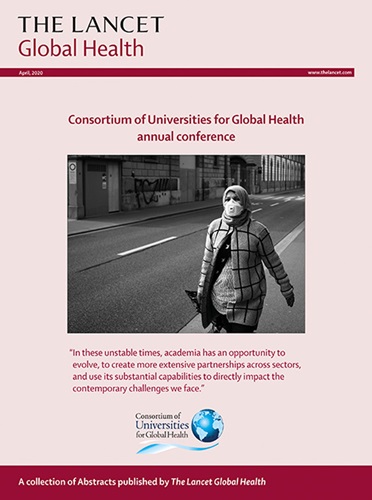Intravenous versus oral iron for anaemia among pregnant women in Nigeria (IVON): an open-label, randomised controlled trial.
IF 19.9
1区 医学
Q1 PUBLIC, ENVIRONMENTAL & OCCUPATIONAL HEALTH
引用次数: 0
Abstract
BACKGROUND Oral iron for anaemia in pregnancy is often not well tolerated, with poor adherence. Iron administered intravenously might address these tolerance and adherence issues. We investigated the effectiveness and safety of intravenous ferric carboxymaltose versus oral ferrous sulphate on anaemia and iron deficiency among pregnant women in Nigeria. METHODS We did a multicentre, open-label, parallel, randomised controlled trial of pregnant women (aged 15-49 years) with haemoglobin (Hb) concentrations of less than 10 g/dL at 20-32 weeks' gestation from 11 primary, secondary, or tertiary health facilities in Nigeria (five in Lagos and six in Kano). Exclusion criteria included vaginal bleeding, blood transfusion or major surgery within the past 3 months, symptomatic anaemia, anaemia known to be unrelated to iron deficiency, clinically confirmed malabsorption syndrome, previous hypersensitivity to any form of iron, pre-existing maternal depression or other major psychiatric illness, immune-related diseases, such as systemic lupus erythematosus or rheumatoid arthritis, or severe allergic reactions. Participants were randomly assigned (1:1) by nurses and doctors using a web-based randomisation service to either receive a single dose of intravenous ferric carboxymaltose (20 mg/kg to a maximum of 1000 mg) or oral ferrous sulphate (200 mg; 65 mg elemental iron) three times daily until 6 weeks postpartum. The study was primarily unmasked. Primary outcomes were maternal anaemia (Hb <11 g/dL) at 36 weeks' gestation and preterm birth at before 37 weeks' gestation, with analysis by intention to treat in participants with available data. This study was registered at the ISRCTN registry on Dec 10, 2020 (ISRCTN63484804) and on ClinicalTrials.gov (NCT04976179) on April 7, 2021. FINDINGS Between Aug 10, 2021, and Dec 15, 2022, 13 724 pregnant women were screened for eligibility. 12 668 were excluded due to ineligibility for inclusion, and 1056 provided consent to participate and were randomly assigned to either the intravenous or oral administration groups. 527 were assigned to the intravenous ferric carboxymaltose group and 529 were assigned to the oral ferrous sulphate group. 518 in the intravenous group were assessed at 36 weeks' gestational age and after 518 deliveries, and 511 completed the 6 weeks postpartum visit. 513 in the oral ferrous sulphate group were assessed at 36 weeks' gestational age and after 512 deliveries, and 501 completed the 6 weeks postpartum visit. No significant difference was found in anaemia at 36 weeks (299 [58%] of 517 in the intravenous group vs 305 [61%] of 503 in the oral group; risk ratio 0·95, 95% CI 0·85-1·06; p=0·36), nor in preterm birth (73 [14%] of 518 vs 77 [15%] of 513; 0·94, 0·70-1·26; p=0·66). There were no significant differences in adverse events. The most common adverse events were diarrhoea (in six participants) and vomiting (in three participants) in the oral group and fatigue (in two participants) and headache (in two participants) in the intravenous group. INTERPRETATION Although the effect on overall anaemia did not differ, intravenous iron reduced the prevalence of iron deficiency to a greater extent than oral iron and was considered to be safe. We recommend that intravenous iron be considered for anaemic pregnant women in Nigeria and similar settings. FUNDING Bill & Melinda Gates Foundation.静脉注射与口服铁剂治疗尼日利亚孕妇贫血(IVON):开放标签随机对照试验。
背景:口服铁剂治疗妊娠期贫血的耐受性往往不佳,而且依从性也很差。静脉注射铁剂可以解决这些耐受性和依从性问题。我们调查了静脉注射羧甲基亚铁与口服硫酸亚铁对尼日利亚孕妇贫血和缺铁的有效性和安全性。方法 我们对尼日利亚 11 家一级、二级或三级医疗机构(5 家在拉各斯,6 家在卡诺)中妊娠 20-32 周、血红蛋白(Hb)浓度低于 10 g/dL 的孕妇(年龄在 15-49 岁之间)进行了多中心、开放标签、平行随机对照试验。排除标准包括阴道出血、过去 3 个月内输血或接受过大手术、无症状性贫血、已知与缺铁无关的贫血、临床证实的吸收不良综合征、既往对任何形式的铁过敏、既往患有抑郁症或其他重大精神疾病、免疫相关疾病(如系统性红斑狼疮或类风湿性关节炎)或严重过敏反应。参与者由护士和医生通过网络随机分配(1:1),接受单剂量静脉注射羧甲基亚铁(20 毫克/千克,最多 1000 毫克)或口服硫酸亚铁(200 毫克;65 毫克元素铁),每天三次,直至产后 6 周。该研究主要是无掩蔽研究。主要结果为妊娠 36 周时的产妇贫血(Hb <11 g/dL)和妊娠 37 周前的早产,对有数据的参与者进行意向治疗分析。该研究于 2020 年 12 月 10 日在 ISRCTN 注册中心注册(ISRCTN63484804),并于 2021 年 4 月 7 日在 ClinicalTrials.gov 注册(NCT04976179)。结果在 2021 年 8 月 10 日至 2022 年 12 月 15 日期间,共筛选出 13 724 名符合条件的孕妇。12 668 名孕妇因不符合纳入条件而被排除,1056 名孕妇同意参与并被随机分配到静脉注射组或口服组。527 人被分配到静脉注射羧甲基亚铁组,529 人被分配到口服硫酸亚铁组。静脉注射组中有 518 人在妊娠 36 周和 518 次分娩后接受了评估,511 人完成了产后 6 周的访视。口服硫酸亚铁组有 513 人在孕 36 周和 512 次分娩后接受了评估,501 人完成了产后 6 周的访视。36 周时的贫血率(静脉注射组 517 例中的 299 [58%] vs 口服组 503 例中的 305 [61%];风险比 0-95,95% CI 0-85-1-06;p=0-36)和早产率(518 例中的 73 [14%] vs 513 例中的 77 [15%];0-94,0-70-1-26;p=0-66)均无明显差异。不良反应方面没有明显差异。口服组最常见的不良反应是腹泻(6 人)和呕吐(3 人),而静脉注射组最常见的不良反应是疲劳(2 人)和头痛(2 人)。我们建议尼日利亚和类似地区的贫血孕妇考虑静脉注射铁剂。
本文章由计算机程序翻译,如有差异,请以英文原文为准。
求助全文
约1分钟内获得全文
求助全文
来源期刊

Lancet Global Health
PUBLIC, ENVIRONMENTAL & OCCUPATIONAL HEALTH-
CiteScore
44.10
自引率
1.20%
发文量
763
审稿时长
10 weeks
期刊介绍:
The Lancet Global Health is an online publication that releases monthly open access (subscription-free) issues.Each issue includes original research, commentary, and correspondence.In addition to this, the publication also provides regular blog posts.
The main focus of The Lancet Global Health is on disadvantaged populations, which can include both entire economic regions and marginalized groups within prosperous nations.The publication prefers to cover topics related to reproductive, maternal, neonatal, child, and adolescent health; infectious diseases (including neglected tropical diseases); non-communicable diseases; mental health; the global health workforce; health systems; surgery; and health policy.
 求助内容:
求助内容: 应助结果提醒方式:
应助结果提醒方式:


